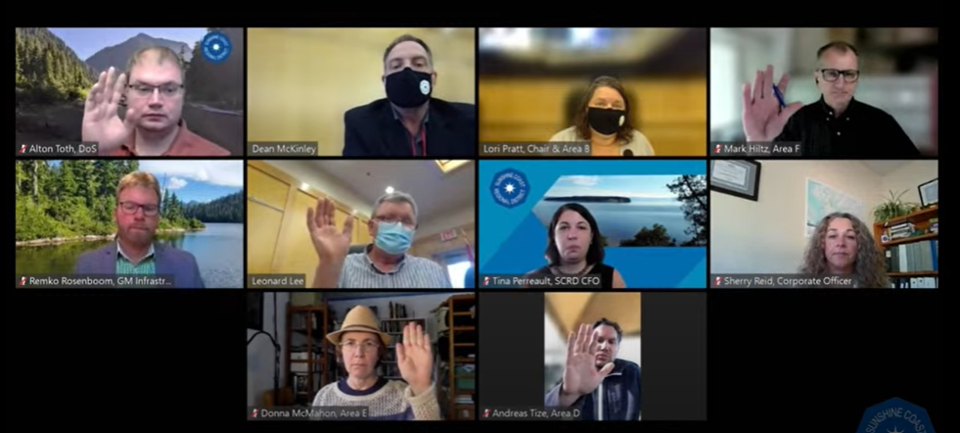Gibsons council will be deciding at an Aug. 31 meeting whether to proceed with supplying the Sunshine Coast Regional District (SCRD) with 1,000 cubic metres of water per day.
At a special emergency board meeting on Aug. 27, staff told the SCRD board they are working on developing an agreement with Town of Gibsons staff regarding emergency water supply.
The water would equate to three days of extra water supply per month in use or about nine per cent of the daily community demand, and would be transferred from the Town of Gibsons’ Zone 3 to Zone 3 of the SCRD (areas of Elphinstone and West Howe Sound).
“It doesn’t sound like a lot, but those three days can really make a difference between running out of water for three days or until a big rainstorm falls in October,” Remko Rosenboom, general manager of infrastructure services and deputy director of the Emergency Operation Centre, said.
If both the SCRD and Town of Gibsons agree, it could commence after the Labour Day long weekend.
The SCRD would pay incremental costs to Gibsons to cover staffing and operational costs up to $35,000. At the end of the year, the SCRD would provide an equal amount of water back to the Town of Gibsons so the annual licence amount for either party would not be affected.
A bulk water station has been opened in Langdale for at least 1,000 litres of water. Interested residents and commercial users have to connect with the SCRD to set up an appointment. A staff member is required to operate the hydrant.
The SCRD activated an Emergency Operation Centre (EOC) earlier in the week, on Aug. 23.
Current conditions
The Chapman water system benefitted from a recent drop in temperatures, a decrease in daily water use and two separate days of rain. On Aug. 20, 11 millimetres of rain added three days of extra water supply, Rosenboom said, followed by six millimetres of rain at Chapman Lake on Aug. 26.
“With the current community demand, which is less than 11,000 cubic metres a day, we should be fine if we stay in Stage 4 until late September, in terms of water supply,” Rosenboom said, adding the situation is better than two weeks ago, when the water was estimated to run out as early as mid-September.
While an updated forecast is expected early next week from Environment Canada, there is almost no rain expected for the next two weeks. The three-month forecast issued on July 31 showed warmer-than-usual temperatures for September and October. In 2012 and 2017, drought conditions continued into October.
As of Aug. 27, BC Ferries will give on-board announcements on both routes servicing the Sunshine Coast explaining there’s a water shortage and asking everyone to be more mindful of water use. At this time, Rosenboom said the SCRD is not actively discouraging tourism to the Coast.
“Yes, everyday helps, but I don’t think after Labour Day long weekend tourism is the biggest drive for consumption on the Coast anymore as it is now,” he said.
The SCRD board also moved to request a meeting with Premier John Horgan to discuss the water supply on the Sunshine Coast.
Elphinstone director Donna McMahon expressed concern for next summer’s water supply. Rosenboom said staff hopes the Church Road well will be online prior to the end of summer, but the current efforts are focused on preventing the water from running out. The tender for the Church Road well has been drafted, and can be finalized once the SCRD knows the licence’s terms and conditions, Rosenboom said.
Edwards Lake siphons
Other emergency measures the SCRD is currently pursuing include adding siphons at Edwards Lake, which could provide several weeks of water supply if the SCRD is successful with getting authorization and meeting requirements. The environmental, geological and archeological impact assessments have been initiated, and a design is to be finalized.
Other challenges a siphon system at Edwards Lake would face include the short timeline, availability and delivery of materials. A total cost would be a maximum of $200,000.
The channel from Chapman Lake is almost completely dry, Rosenboom said, and the water level at Edwards Lake is dropping inches per day as well. If the Chapman Lake siphon system or the Edwards Lake valve become inoperable due to low water levels, 50 per cent of the water supply will be lost. Combined, the two systems are currently providing 75 per cent of the water supply.
While Trout Lake is also being considered as an intake, the water licence only allows 227 cubic metres of water per day from that source – approximately 15 hours of extra water per month in use.
According to a press release, staff are also investigating the potential use of desalination systems. Due to the small amount of water desalination would add to the supply, early estimates show this likely will not be an option.
Costs approved
The SCRD board voted to approve the estimated costs based on the EOC being active until Oct. 15.
The estimated $200,000 cost of the Edwards siphon system would come out of the regional water service capital reserves, while an estimate of up to $217,500 for operational expenditures will be absorbed by the regular 2021 operational budget for the regional water service. SCRD staff will also discuss the potential reimbursement of some of these expenditures with Emergency Management BC.
All directors were in favour. Gibsons Mayor Bill Beamish and Sechelt Mayor Darnelda Siegers were not present for the vote.
A status update on the water supply and emergency measures is expected at a Sept. 9 SCRD meeting.



